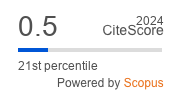A possible interconnection between the sensitivity to phenyltiokarbimid and alcohol dependence
Abstract
The aim of this research is to investigate the connection between sensitivity to phenyltiokarbimid (PHTK) and alcohol dependence. The determination of the sensitivity to PHTK is based on those methodes named after H. Harris and H. Kalmus (1949). The distribution of PHTK sensitivity is studied on the amount of 91 patients: 59 of them are with the diagnosis «moderate nonalcoholic syndrome», 33 of them are with the diagnosis «the syndrome of alcohol and delirium cancellation». The group of patients under consideration consisted of 29 healthy men. Statistically significant lowering of the threshold of taste sensitivity to PHTK is revealed. The conclusion is that a significant amount of non-sensitive patients who are alcohol dependent are found.
About the Authors
O. V. MyachinaRussian Federation
PhD, assistant of the chair of biology with ecology
A. A. Zuykova
Russian Federation
MD, prof, head of chair of general medical practice (family medicine)
A. N. Pashkov
Russian Federation
prof., head of chair of biology with ecology
S. N. Popov
Russian Federation
deputy doctor-in-chief of the Voronezh regional psychoneurological dispensary, lecturer
References
1. Иванец Н.Н., Анохина И.П. Актуальные проблемы алкоголизма // Психиатрия и психофармакотерапия. 2004. Т. 6. № 3. С. 100–105.
2. Кошкина Е.А. Наркологическая ситуация в Российской Федерации в 1999–2002 гг. // Наркология. 2004. № 1. С. 16 – 21.
3. Mulligan C., Robin R., Osier M. et al. Allelic variation at alcohol metabolism genes (ADH1B, ADH1C, ALDH2) and alcohol dependence in an American Indian population. Hum Genet. 2003; 113: 325 – 336.
4. Osier M., Pakstis A.J., Kidd J.R. et al. Linkage disequilibrium at the ADH2 and ADH3 loci and risk of alcoholism. Am J Hum Genet. 1999; 64: 1147–1157.
5. Oota H., Pakstis A.J., Bonne-Tamir B. et al. The evolution and population genetics of the ALDH2 locus: random genetic drift, selection, and low levels of recombination. Ann Hum Genet. 2004; 68 (Pt 2): 93–109.
6. Song J., Koller D.L., Foroud T. et al. Association of GABA(A) receptors and alcohol dependence and the effects of genetic imprinting. Am J Med Genet. 2003; 117B: 39–45.
7. Иванец Н.Н., Анохина И.П., Винникова М.А. Наркология: национальное руководство. М.: ГЭОТАР- МЕДИА, 2008.
8. Тресков В.Г., Шувалов А.В., Кикта С.В. Генетические маркеры и алкоголизм: Обзор // МРЖ. 1985. № 1. Разд. 14. С. 1–7.
9. Driscoll K.A., Perez M., Cukrowicz K.C. et al. Associations of phenylthiocarbamide tasting to alcohol problems and family history of alcoholism differ by gender. Psychiatry Res. 2006; 143 (1): 21–27.
10. Harris H, Kalmus H. The measurement of taste sensitivity to phenylthiourea (P.T.C.). Ann Eugen. 1949; 15: 24–31.
11. DiCarlo S., Powers A. Propylthiouracil tasting as a possible genetic association marker for two types of alcoholism. Physiol Behav.1998; 64: 147–152.
12. Reid N., Brunt P., Bias W. et al. Genetic characteristics and cirrhosis: a controlled study of 200 patients. Br Med J. 1968; 2: 463–465.
13. Smith S. Taste thresholds in drug addicts and alcoholics. Br J Addict. 1972; 67: 317–321.
14. Swinson R. Phenylthiocarbamide taste sensitivity in alcoholism. Br J Addict. 1973; 68: 33–36.
15. Pelchat M., Danowski S. A possible genetic association between PROP-tasting and alcoholism. Physiol Behav. 1992; 51: 1261–1266.
16. Kranzler H., Skipsey K., Modesto-Lowe V. PROP taster status and parental history of alcohol dependence. Drug Alcohol Depend. 1998; 52: 109–113.
17. Bartoshuk L., Duffy V., Fast K. et al. What makes a supertaster (abstract)? Chem Senses. 2001; 26: 1074.
18. Bartoshuk L., Conner E., Grubin D. et al. PROP supertasters and the perception of ethyl alcohol. Chem Senses.1993; 18: 526–527.
19. Duffy V.B., Peterson J.M., Bartoshuk L.M. Associations between taste genetics, oral sensation and alcohol intake. Physiol Behav. 2004; 82: 435–445.
20. Prescott J., Swain-Campbell N. Responses to repeated oral irritation by capsaicin, cinnamaldehyde and ethanol in PROP tasters and nontasters. Chem Senses. 2000; 25: 239–246.
21. Intranuovo L., Powers A. The perceived bitterness of beer and 6-n-propylthiouracil (PROP) taste sensitivity. Ann NY Acad Sci. 1998; 855: 813–815.
22. Pickering G., Simunkova K., DiBattista D. Intensity of taste and astringency sensations elicited by red wines is associated with sensitivity to PROP (6-n-proplthiouracil). Food Qual Pref. 2004; 15: 147–154.
23. Mattes R.D., DiMeglio D. Ethanol perception and ingestion Physiol Behav. 2001; 72: 217–229.






































